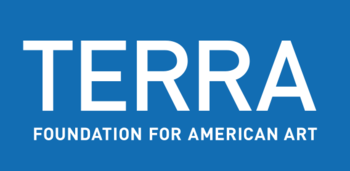Chicago’s Cook County Jail is one of the largest single-site jails in the U.S. Its 96 acre-site is located in the neighborhood of Little Village, affectionately known as La Villita by its Mexican-American residents. The Chicago-born artist Maria Gaspar grew up here, in the shadow of the jail’s expansive walls, and at the age of twelve visited the jail on a school field trip. The purpose of the trip was to scare the minors straight in order to avoid a life of delinquency, but for Gaspar, the trip left an indelible mark. As a witness to confinement, she noted, “I remember feeling like the guys behind bars looked like people down my block.”
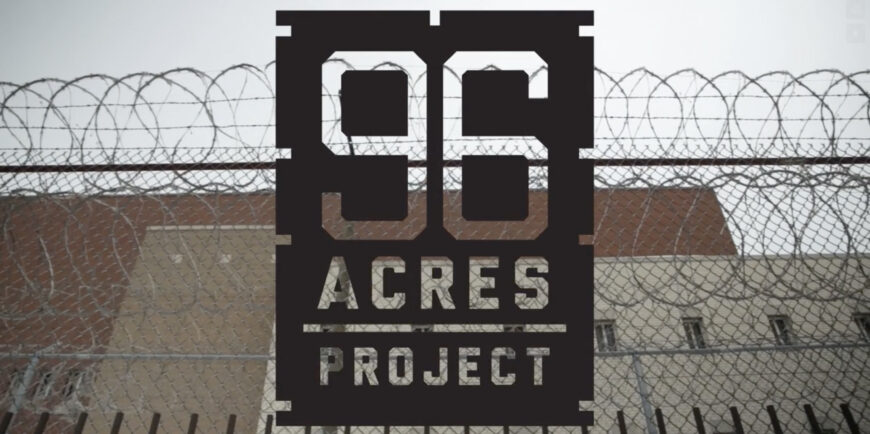
Maria Gaspar, 96 Acres Project, 2012–16 (photo: courtesy of Maria Gaspar)
Facilitator, negotiator, and advocate
In 2012, Gaspar began one of her most ambitious socially engaged art projects, one that required a host of artistic and criminal justice partnerships. She titled it the 96 Acres Project. The multi-year and multimedia work produced eight site-responsive public actions. [1] These site-responsive projects involved collaborations with youth, teachers, activists, artists, family members, officials, and men and women who are incarcerated in the Cook County Department of Corrections. The collaborative nature of this social practice often placed Gaspar in the role of facilitator, negotiator, and advocate among these various stakeholders.
A majority of those admitted to the jail are pre-trial detainees who will be released after posting bail. Studies show, however, that a number of these detainees are unable to pay those fees and must remain behind bars. The 96 Acres Project created a number of opportunities for the community to reflect on the impact of incarceration which disproportionately affects people of color, as well as on the role of prison architecture which is often located in impoverished neighborhoods.

Maria Gaspar interviewed by Richard Steele on WBEZ’s “The Barbershop Show” (photo: courtesy of Maria Gaspar)
Perhaps due to her mother’s work in radio in the 1980s, Gaspar has also employed this technology as part of her research. Using audio-visual equipment she recorded the stories of the incarcerated, their family members, and neighbors, creating a richly textured archive of their experiences in and outside the jail. Through a residency with the local radio station Vocalo 90.7 FM, Gaspar developed an audio documentary titled Cook County Jail: The Visible and Invisible (2013), which questioned the spatial politics of the large prison and the impact it has on Little Village.
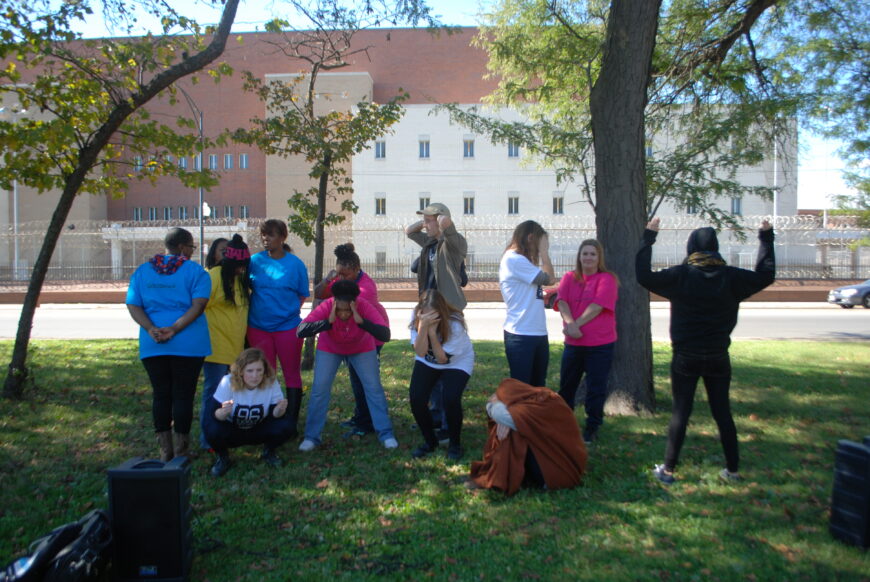
Maria Gaspar, Visibility Project, 96 Acres Project with the Visible Voices Ensemble and the Goodman Theater, Site-specific performance at Cook County Department of Corrections, Chicago, 2014 (photo: courtesy of Maria Gaspar)
Public action
The first site-responsive project to take shape outside the walls of the prison involved theater. Through a collaboration with the Visible Voices Ensemble, a group of formerly incarcerated women and Bobby Biedrzycki of the Goodman Theater, 96 Acres hosted the Visibility Project in 2014. The focus of this public action was to advocate and create space for women transitioning from incarceration, but also to send a message of hope and solidarity to those who remain locked up. Referencing the techniques developed by Augusto Boal’s Theatre of the Oppressed, the group used performance to act out the difficult emotions they experienced through their transition. As one ensemble member reflected, “I’m a firsthand experience that we merely made a mistake, we’re not mistakes.” They also invited the audience to collaborate with them on designing and flying kites that could be seen by some of the detainees across the wall.
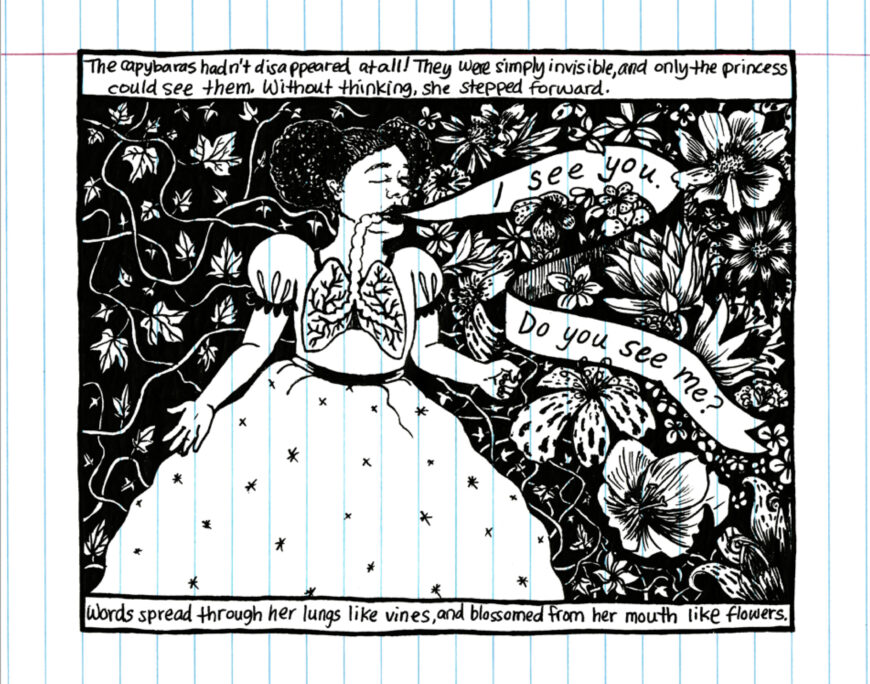
Bianca Diaz, The Princess Who Went Quiet (excerpt from book), with 96 Acres Project and Project NIA, children’s book, 2015, ink on paper, 8.5 x 11 inches (photo: courtesy of Bianca Diaz)
Parents and children
Among the most poignant experiences that are brought to light through 96 Acres is the effects of incarceration on children who have a parent or caregiver in the correctional system. The artist and illustrator Bianca Diaz created a comic book The Princess Who Went Quiet that expresses the feelings of shame and profound loss that children and parents endure as a result of incarceration. After completing a seminar with the renowned abolitionist Mariame Kaba, founder of an advocacy organization known as Project NIA, Diaz began hosting workshops with formerly incarcerated parents and asking what they would have wanted their children to know about the process. Their stories became the source of inspiration for the comic book, which intentionally takes the form of a simple composition notebook with black ink illustrations, simple materials that one could potentially obtain even while in custody. The protagonist of the story is a girl who becomes trapped in the belly of a dragon, and in order to free herself must learn to use her voice to free others. 96 Acres and Project NIA sponsored the publication and distributed the comic book for free at Cook County Jail as well as through Grace Episcopal Church. It offered parents a way to speak openly with their children about life in prison.
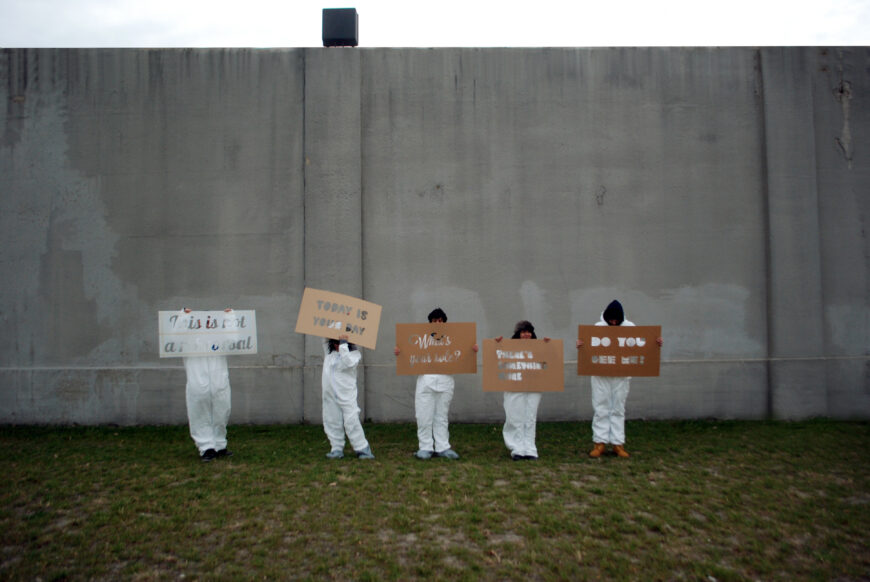
Maria Gaspar, Not Just Another Day, Yollocalli Arts Reach with 96 Acres Project, site-specific installation, 2015 (photo: courtesy of Maria Gaspar)
96 Acres likewise engages young people in issues of spatial justice and the effects of incarceration. In Not Just Another Day, the youth initiative Yollocalli Arts Reach from the National Museum of Mexican Art in Chicago brought together a group of teens to do an act of reverse graffiti on the exterior walls at the perimeter of the jail. Through conversations on the impact of Cook County Jail with the artist, a number of phrases that resonated with the youth were cut out into stencils: “Today is your day”; “What’s your role?”; “This is not a rehearsal”; “Do you see me?” Assembled into small groups, the youth would hold up the stencils to the wall or sidewalk while another would use the pressure washer to etch the phrase onto the surface. Through these poetic interventions of cleaning and reclaiming a site for those who have been banished, the youth hoped to spark questions about our complicity in enabling mass incarceration and our unwillingness to acknowledge the conditions and circumstances of those who live inside.
96 Acres has had a lasting impact on what it means for artists in Chicago to engage in social practice, but also to literally reduce the scale of incarceration in Little Village. The Cook County Department of Corrections began citing a reduction in population numbers since 2016, and by 2021 began to demolish two former dormitories built in the early 1900s to be replaced by a new recreational space for detainees. Gaspar documented the demolition in a series of time-lapse photos. Her ongoing work on the subject as a witness to the destruction of these carceral structures and the reduction in population numbers works towards a horizon of abolition.
Notes:
[1] The 96 Acres Project includes The Visibility Project with the Goodman Theater and The Visible Voices Ensemble (2014); Portraits of Resolution with William Estrada and Anthony Rea (2014); Not Just Another Day with Yollocalli Arts Reach (2014); The Princess Who Went Quiet with Bianca Diaz (2015); Stories from the Inside/Outside with Claudia Rangel and Susan Mullen (2015); Who is Response(able)? with Regin Igloria (2015); Making Corrections with Damon Lamar Reed (2015); and PARK with Landon Brown (2015).
Additional resources
Learn more about the 96 Acres Project on Gaspar’s website
Watch an interview with Maria Gaspar and art historian Nicole Fleetwood
Nicole R. Fleetwood, Marking Time: Art in the Era of Mass Incarceration (Cambridge: Harvard University Press, 2020).
Risa Puleo, Walls Turned Sideways: Artists Confront the Justice System (Houston: Contemporary Arts Museum Houston, 2019).
Daniel Quiles, “Interview with Maria Gaspar,” Artforum, Sept. 11, 2018.
Rebecca Zorach, “Abolition Art: Contemporary Imaginings Against the Carceral State,” The Routledge Companion to Art and Activism in the Twenty-First Century (New York: Routledge, 2023), pp. 216–27.
This essay is part of Smarthistory’s Latinx Futures project and was made possible thanks to support from the Terra Foundation for American Art.

